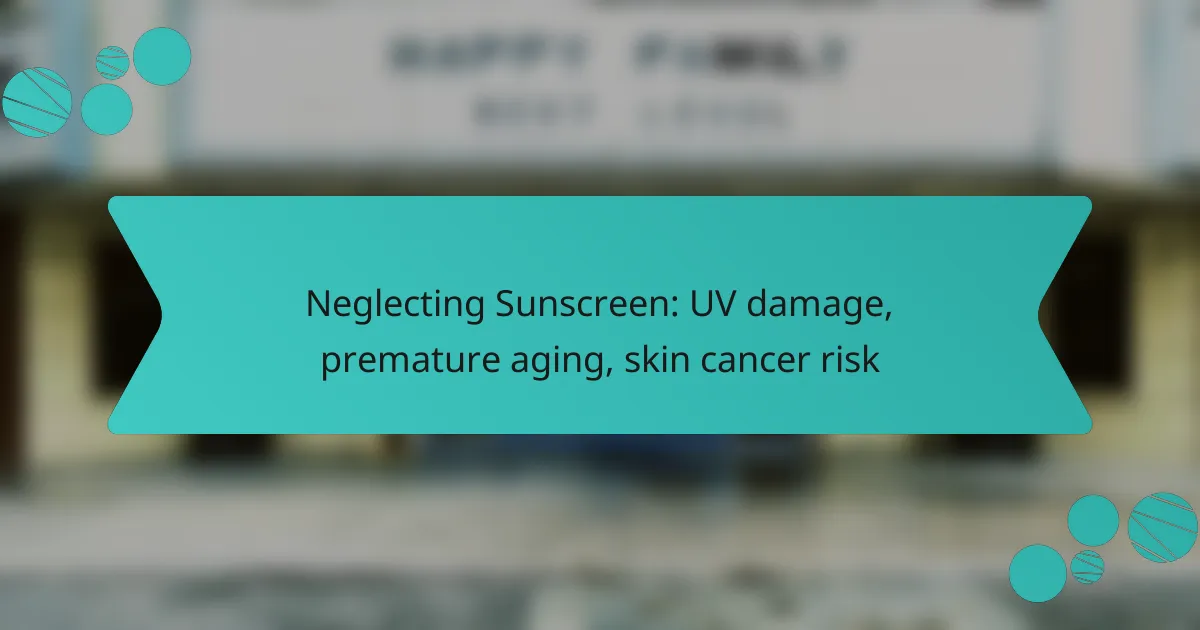Neglecting sunscreen can have serious consequences for your skin, including UV damage that leads to sunburn, premature aging, and an increased risk of skin cancer. Over time, exposure to ultraviolet radiation can cause visible signs of aging, such as wrinkles and age spots, as it damages skin cells and accelerates the aging process. To protect your skin, it’s essential to use a broad-spectrum sunscreen with an SPF of 30 or higher regularly.
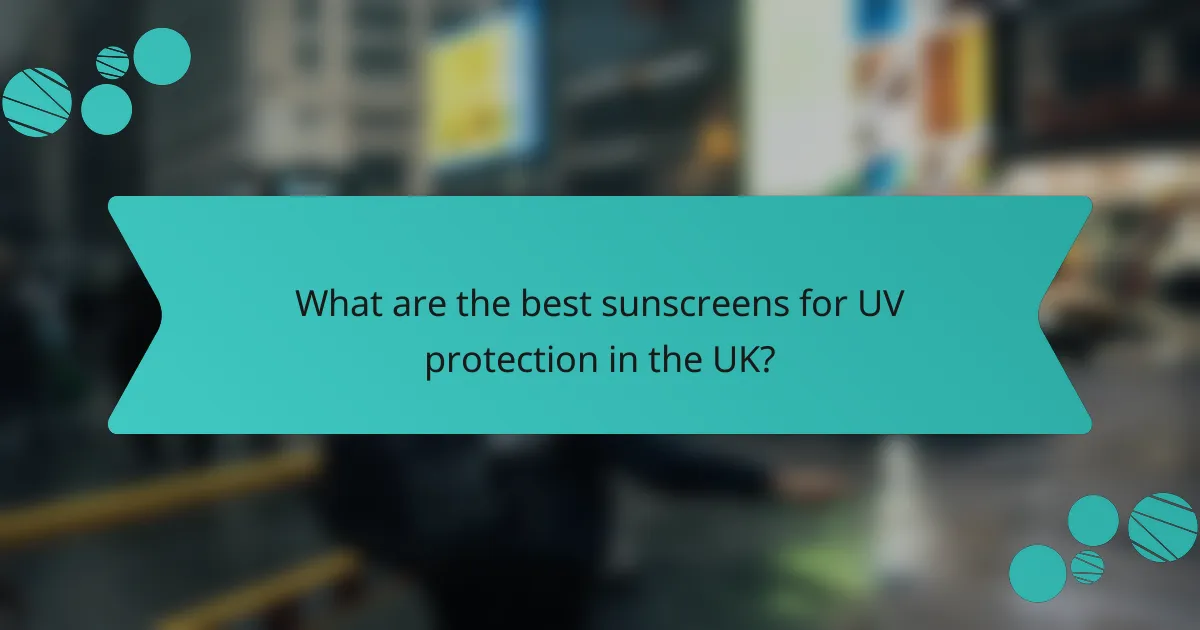
What are the best sunscreens for UV protection in the UK?
The best sunscreens for UV protection in the UK are those that offer broad-spectrum coverage with an SPF of 30 or higher. These sunscreens help shield the skin from both UVA and UVB rays, reducing the risk of sunburn, premature aging, and skin cancer.
SPF 30+ broad-spectrum sunscreens
SPF 30+ broad-spectrum sunscreens are essential for effective UV protection. They block approximately 97% of UVB rays, which are responsible for sunburn and contribute to skin cancer. When selecting a sunscreen, look for products labeled as “broad-spectrum” to ensure they protect against both UVA and UVB rays.
Popular options in the UK include brands like La Roche-Posay, Neutrogena, and Nivea, which offer formulations suitable for various skin types. Always check the SPF rating and ensure it is at least 30 for adequate protection.
Water-resistant options
Water-resistant sunscreens are ideal for outdoor activities, especially in the UK where unpredictable weather can lead to rain or sweat. These products maintain their SPF protection for a specified duration while you are in water or sweating. Look for labels that indicate water resistance for either 40 or 80 minutes.
Brands such as Banana Boat and Coppertone provide water-resistant formulations that are effective for swimming or sports. Reapplication is crucial, especially after swimming or towel drying, to maintain protection.
Mineral vs. chemical sunscreens
Mineral and chemical sunscreens differ in their active ingredients and how they protect the skin. Mineral sunscreens, containing zinc oxide or titanium dioxide, sit on the skin’s surface and reflect UV rays. They are often recommended for sensitive skin and provide immediate protection upon application.
Chemical sunscreens, on the other hand, absorb UV rays and typically contain ingredients like avobenzone or octisalate. They may offer a lighter feel on the skin but can take about 20 minutes to become effective. Choosing between the two depends on personal preference, skin type, and any sensitivities.

How does UV damage affect skin health?
UV damage significantly harms skin health by causing immediate and long-term effects. Overexposure to ultraviolet radiation can lead to sunburn, premature aging, and an increased risk of skin cancer.
Immediate effects of UV exposure
When skin is exposed to UV radiation, it can result in immediate reactions such as redness, swelling, and pain, commonly known as sunburn. This damage occurs because UV rays penetrate the skin and cause inflammation.
In addition to sunburn, immediate UV exposure can lead to skin discoloration and increased sensitivity. Individuals may notice that their skin feels hot or tender after a day in the sun, indicating the need for protective measures.
Long-term skin damage
Long-term UV exposure can lead to significant skin damage, including wrinkles, fine lines, and loss of elasticity. These changes occur as UV rays break down collagen and elastin fibers in the skin, leading to premature aging.
Moreover, prolonged exposure increases the risk of developing skin cancer, particularly melanoma and non-melanoma types. Regular use of sunscreen and protective clothing can mitigate these risks, emphasizing the importance of consistent sun protection throughout the year.
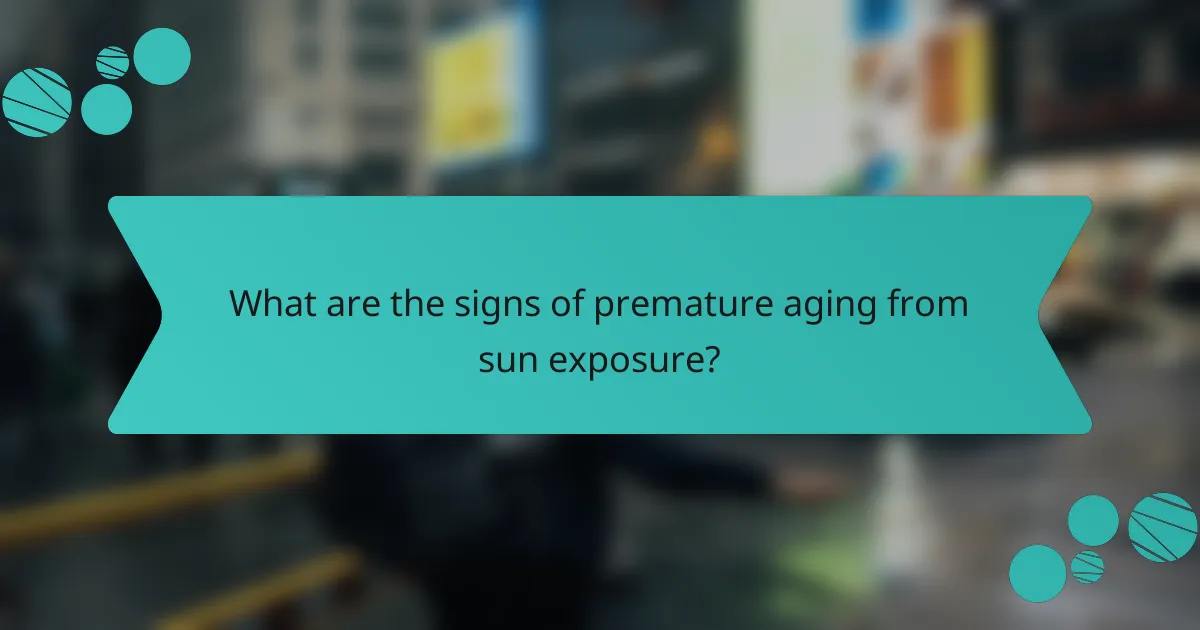
What are the signs of premature aging from sun exposure?
Signs of premature aging from sun exposure include visible changes in skin texture and tone, which can manifest as wrinkles, fine lines, and age spots. These effects are primarily due to ultraviolet (UV) radiation damaging skin cells and accelerating the aging process.
Wrinkles and fine lines
Wrinkles and fine lines are among the most noticeable signs of sun-induced aging. UV rays break down collagen and elastin, essential proteins that keep skin firm and elastic. As a result, skin loses its youthful appearance, leading to deeper creases and a rough texture.
To mitigate these effects, it’s crucial to apply broad-spectrum sunscreen with an SPF of at least 30 daily, even on cloudy days. Regular use of moisturizers and anti-aging products containing retinoids can also help improve skin texture and reduce the appearance of wrinkles.
Age spots and discoloration
Age spots, also known as liver spots or solar lentigines, are flat, brown, or black patches that develop on sun-exposed areas of the skin. These spots occur due to an overproduction of melanin triggered by UV exposure, leading to uneven skin tone.
To prevent age spots, consistent application of sunscreen is essential, particularly on the face, hands, and other exposed areas. Treatments such as chemical peels, laser therapy, or topical lightening agents can help reduce existing spots and promote a more even complexion.
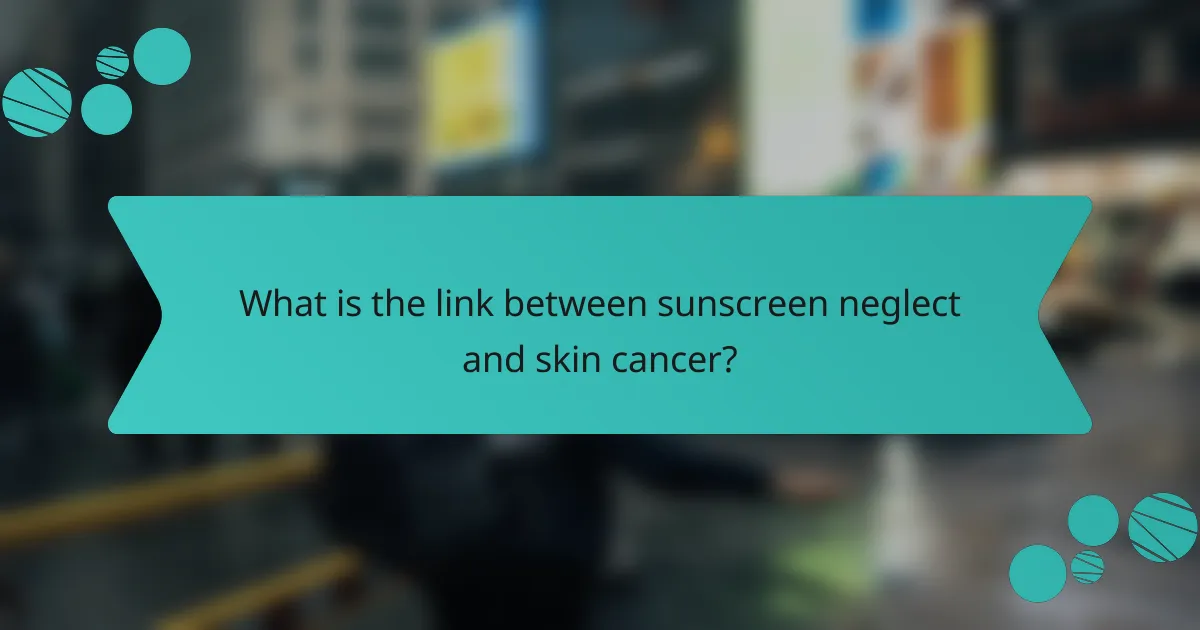
What is the link between sunscreen neglect and skin cancer?
Neglecting sunscreen significantly increases the risk of developing skin cancer due to unprotected exposure to ultraviolet (UV) radiation. Regular use of sunscreen helps protect the skin from harmful UV rays, which can lead to cellular damage and mutations over time.
Types of skin cancer related to UV exposure
The primary types of skin cancer associated with UV exposure are basal cell carcinoma, squamous cell carcinoma, and melanoma. Basal cell carcinoma is the most common and usually appears as a small, shiny bump, while squamous cell carcinoma may present as a firm, red nodule. Melanoma, the most dangerous form, often manifests as a new or changing mole.
UV radiation contributes to the development of these cancers by damaging the DNA in skin cells. Over time, repeated damage can lead to mutations that cause cells to grow uncontrollably, resulting in cancer.
Statistics on skin cancer in the UK
In the UK, skin cancer rates have been rising steadily, with around 16,000 new cases of melanoma diagnosed each year. This increase is attributed to factors such as sun exposure and tanning bed usage. Approximately one in five people in the UK will develop skin cancer in their lifetime.
Early detection is crucial, as the survival rate for skin cancer is significantly higher when diagnosed at an early stage. Regular skin checks and awareness of changes in moles can help in identifying potential issues early on.
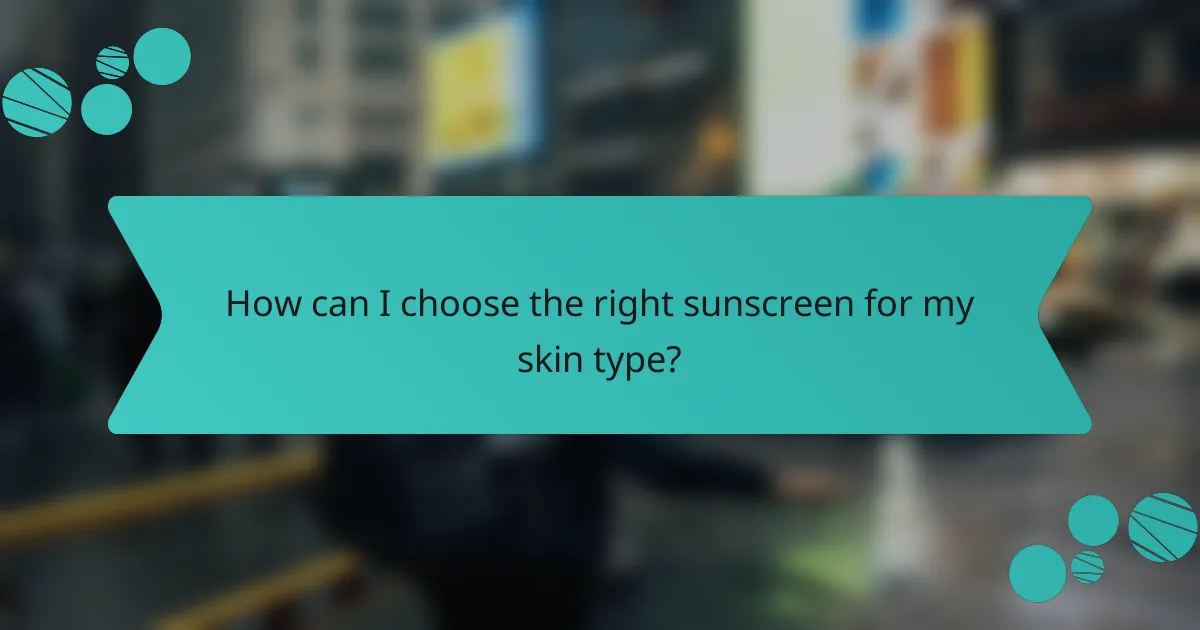
How can I choose the right sunscreen for my skin type?
Choosing the right sunscreen for your skin type involves understanding your skin’s needs and selecting a formula that provides effective protection without causing irritation. Look for products that suit your specific skin characteristics, such as oiliness or dryness, and consider factors like SPF level and water resistance.
Oily skin considerations
If you have oily skin, opt for a sunscreen labeled as “oil-free” or “matte finish” to avoid exacerbating shine and breakouts. Gel-based or lightweight lotions are often ideal, as they absorb quickly and provide a non-greasy feel.
Look for ingredients like zinc oxide or titanium dioxide, which offer broad-spectrum protection without clogging pores. Avoid heavy creams that may lead to acne or irritation.
Dry skin considerations
For dry skin, choose a sunscreen that includes moisturizing ingredients such as hyaluronic acid or glycerin. Creamy formulations can provide hydration while protecting against UV damage.
Consider sunscreens with a higher SPF and those that are labeled as “hydrating” or “nourishing.” Avoid products with alcohol or fragrances, as they can further dry out your skin.

What are the recommended application methods for sunscreen?
To effectively protect your skin from UV damage, apply sunscreen generously and evenly to all exposed areas. Proper application methods can significantly reduce the risk of premature aging and skin cancer.
Amount of sunscreen to use
The general guideline is to use about 1 ounce (approximately a shot glass full) of sunscreen for full-body coverage. For smaller areas, such as the face, about a nickel-sized amount is typically sufficient. Ensure that all exposed skin is covered, including often-missed spots like the ears, neck, and tops of the feet.
Using too little sunscreen is a common mistake that can lead to inadequate protection. Consider using a sunscreen with a higher SPF if you find yourself using less than the recommended amount, as this can help compensate for lower application levels.
Timing for application
Apply sunscreen at least 15 to 30 minutes before going outdoors to allow it to absorb and provide effective protection. This is crucial for both chemical and physical sunscreens, as they need time to form a protective barrier on the skin.
Reapply sunscreen every two hours, or more frequently if swimming or sweating. If you are using a water-resistant formula, check the label for specific reapplication guidelines, as these can vary. Remember that even on cloudy days, UV rays can penetrate and cause skin damage, so consistent application is key.

How often should I reapply sunscreen?
You should reapply sunscreen every two hours for effective protection against UV damage. If you are swimming or sweating, it’s essential to reapply more frequently, typically every 40 to 80 minutes, depending on the product’s water resistance rating.
Reapplication after swimming
After swimming, it is crucial to reapply sunscreen immediately to maintain adequate protection from UV rays. Water can wash away sunscreen, even if it is labeled as water-resistant, so a fresh application is necessary.
Choose a broad-spectrum sunscreen with a high SPF rating to ensure you are protected against both UVA and UVB rays. Look for products that specify their water resistance duration, which can range from 40 to 80 minutes, and plan your reapplication accordingly.
To avoid common pitfalls, dry your skin with a towel before reapplying sunscreen. This helps the product adhere better and provides more effective coverage. Always check the label for specific instructions regarding reapplication after swimming.
